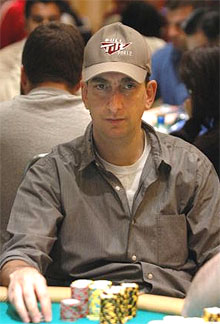|
| Magriel's NYT Columns |

Erik Seidel later became
famous as a poker player Last summer the first International Backgammon Championship of Puerto Rico was held at the Cerromar Beach Hotel in Dorado Beach. This event, sponsored by Rums of Puerto Rico, drew a strong field of internationally recognized experts. Kal Robinson of Los Angeles defeated Peter Gold of London in the best-two-out-of-three 15-point finals match.
Many new young players also turned in excellent performances. For example, 20-year-old Erik Seidel of New York won the consolation, and 18-year-old Jay Whitehead, a San Francisco chess senior master, won the last chance.
In the diagrammed position, Seidel (Black) demonstrated the mature judgment that enabled him to beat a strong opponent in the consolation finals match. The game is still in its formative stage; neither side has yet made a point in the home boards. Although White has had a third man sent back, he has compensated by establishing Black’s bar-point (the 7-point).
|
| Black to play 2-1. |
At the beginning of the game, Black’s first priority is to rapidly bring all his men into play and attempt to establish new points. Black correctly plays 15/14, 6/4.
|
An inflexible position |
White's 2's are triplicated |
Notice also that the danger of being hit is not as great as may first appear. Even though Black has left three men exposed (on the 4-, 9-, and 14-points), White needs the same number, a 2, to hit in each place. The number that White needs to hit with, 2, is said to be “duplicated.” By duplicating White’s good numbers, Black reduces his chance of being hit — despite his three blots, he is effectively leaving only a single direct shot instead of a double or triple shot.
Rollout
 Tom Keith 2013 |
|
Money play Centered cube Black rolls 2-1 1296 games with VR Checker play: 2-ply Cube play: 3-ply Red |
| 2-1: | Game | G | BG | Equity | ||||
| 1 | 15/13, 9/8 |
W L |
.5078 .4922 |
.0629 .1222 |
.0019 .0022 | −0.0216 |

| (a) |
| 2 | 13/10 |
W L |
.5024 .4976 |
.0954 .1456 |
.0057 .0057 | −0.0353 | (0.0137) | |
| 3 | 15/14, 6/4 |
W L |
.4962 .5038 |
.0887 .1389 |
.0037 .0044 | −0.0604 | (0.0388) | (b) |

|
|

